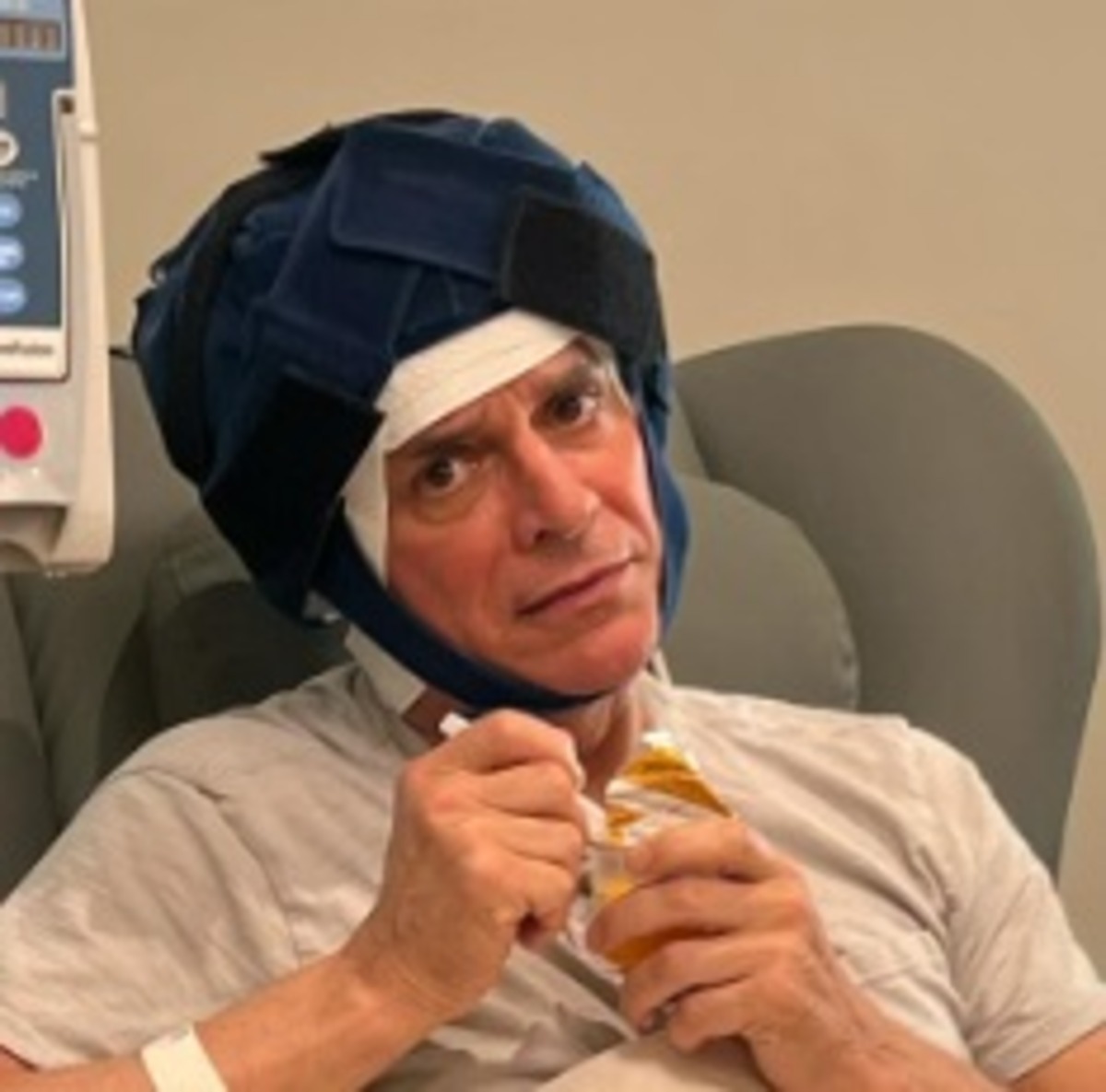Coping with Multiple Myeloma Relapse
- “Young and the Restless” actor Christian LeBlanc, 65, is battling multiple myeloma. Although he reached remission last Fall, more recent photos show him undergoing chemotherapy while wearing a cold cap device to preserve his hair. Multiple myeloma is an incurable disease with a high chance of relapse. However, treatment options exist to manage its recurrence.
- Multiple myeloma is a rare type of blood cancer that hinders the body’s ability to fight infections. It can cause weakness, dizziness, bone pain, and confusion, among other symptoms.
Advancements in multiple myeloma maintenance treatments have improved the lives of patients battling the disease. - If losing your hair is a concern for you before cancer treatment, know you have options like wigs, hats, wraps, and scarves, among other things, to maintain your self-esteem.
- Scalp cooling devices such as the one LeBlanc used to constrict the blood flow to the scalp caps limit the amount of circulating chemotherapy that reaches the hair follicles, protecting them from some of the chemo’s damaging effects.
“Young and the Restless” actor Christian LeBlanc, 65, is working his way through multiple myeloma treatment. He was diagnosed last summer with the disease, which hinders the body’s ability to fight infections. Amid treatment, he’s keeping his sense of humor and channeling past Hollywood favorites to keep his spirits high.
“Who am I, Gloria f—–g Swanson???” he posted in a caption while wearing a cold cap, which helps preserve hair follicles during cancer treatment.


“How do you do it? Love your spirit!” Instagram user Jennifer Gareis commented.
Although LeBlanc announced he was in remission last Fall, as of December 2023, he shared an Instagram photo of him wearing a cold cap. However, even if he reaches remission, multiple myeloma patients face the risk of relapse.
Helping Patients Better Understand Multiple Myeloma
- ‘An Important Step Forward’: New Drug Combo Shows Promise For The Treatment of Some Ovarian Cancer
- A Great New Option For Multiple Myeloma Patients: Daratumumab Now Available As a Quick Shot, Replacing Long Infusions
- Advocating for Yourself is the Most Important Thing: Multiple Myeloma Survivor Ann Bogle's Story
- Are the Treatments the Same for a Second or Third Relapse of Multiple Myeloma?
Multiple Myeloma Relapse
When your multiple myeloma comes back within about a year, your disease is generally classified as ‘high risk.’
When multiple myeloma returns after treatment, “It usually means that there were residual cells, even in very small numbers. They were either resistant to the treatment from the start, or they acquired resistance as the treatment was growing,” Dr. Kenneth Anderson, Director of Dana Farber Cancer Institute’s Multiple Myeloma Center, explains to SurvivorNet.
In other words, not every myeloma cell in your body is precisely the same. Some start with a set of mutations that can give them resistance to treatments and make them more likely to relapse, whereas others develop mutations as a result of treatment.
The Signs of a Multiple Myeloma Relapse
- Increased levels of monoclonal antibodies: myeloma cells are cancerous plasma cells in the bone marrow which overgrow and produce abnormal proteins. These abnormal proteins are released in the blood and can be detected by physicians. When the levels of these increase substantially, that can be a sign multiple myeloma has relapsed.
- Increase in plasma cells in the bone marrow: oncologists can use magnetic imaging, like MRI or PET scans, to see if there are a greater than normal level of plasma cells in the bone marrow, typical of overly dividing myeloma cells.
- Bone fractures and lesions: myeloma cells activate the cells that break down bones and deactivate the cells that build up bones, which can result in fractures or small holes in bones. Oncologists can use X-rays or CT scans to pick up on bone damage that is indicative of relapse.
When or if multiple myeloma returns, many treatment options exist.
“Just because myeloma returns doesn’t mean it can’t be effectively treated with many years of quality life,” Dr. Anderson said.
Among multiple myeloma patients who are doing well include veteran journalist Tom Brokaw, who was diagnosed in 2013. He found success with the chemotherapy drug Revlimid (generic name lenalidomide), which has been shown to improve survival for multiple myeloma patients.
WATCH: Journalist Tom Brokaw’s multiple myeloma journey.
Myeloma cells that have survived after undergoing multiple rounds of various treatments to cause relapse are typically the most resistant. This occurs because relapsed myeloma cells have over twice as many mutations as when the disease previously appeared. This meant they have twice as many ways of resisting previous treatments.
To treat this highly resistant form of the disease, second-generation drugs are an option. These are more recent adjustments and improvements to existing therapies.
For relapsed patients, the second-generation treatments include:
- Kyprolis (carfilzomib) – is a proteasome inhibitor.
- Pomalyst (pomalidomide) – 2nd generation immunomodulatory.
- Dexamethasone – a mainstay of myeloma treatment in both relapsed and initially diagnosed patients.
Daratumumab, an immunotherapy, is also added to the mix. More specifically, Dara is a monoclonal antibody that ‘tags’ cancer cells for quick and efficient recognition by the immune system.
In myeloma patients whose disease has returned repeatedly, oncologists may turn to therapies approved only for clinical trials, namely CAR T-cell therapy.
“We’re using the CAR T-cells now literally in patients who have no other options,” explains Dr. Anderson. CAR T-cells are immune cells harvested from a patient’s body, genetically modified to target specific cells (like multiple myeloma), and then reinfused back into a patient.
For more options following multiple myeloma relapse, clinical trials may offer a solution. SurvivorNet has extensive resources about how to access these options as well.
LeBlanc’s Efforts to Preserve His Hair Using a Cold Cap
Cryotherapy involves wearing cold caps or special cooling caps before, during, and after each chemotherapy treatment.
Scalp-cooling devices have been approved by the FDA recently, first for breast cancer and then several other cancers. That means wearing cold caps or special cooling caps before, during, and after each chemotherapy treatment. The caps, which are tightly fitting and strap-on helmet-style, are filled with a gel coolant that’s chilled to between -15 to -40 degrees Fahrenheit.
Essentially, the caps “cause vasoconstriction, or a narrowing of the blood vessels bringing blood to the scalp,” Dr. Renata Urban, gynecologic oncologist at the University of Washington, explains.
WATCH: What is a scalp-cooling device?
By constricting the blood flow to the scalp, the caps limit the circulating chemotherapy that reaches the hair follicles, protecting them from some of the chemo’s damaging effects.
The cold also decreases the activity of the hair follicles, which slows down cell division and makes the follicles less affected by the chemotherapy medicine.
Dr. Julia Nangia, a medical oncologist at Baylor College of Medicine and a lead author on one of the major studies of the device, says 50% of women were able to keep their hair after four rounds of chemotherapy, and added: “Without the devices, 100% of patients lost their hair.”
There have been some safety questions when it comes to scalp-cooling, but Dr. Nangia says that when given to people with solid tumors (like breast, ovarian, colon, and lung cancer), the devices are safe.
Learn more about SurvivorNet's rigorous medical review process.




